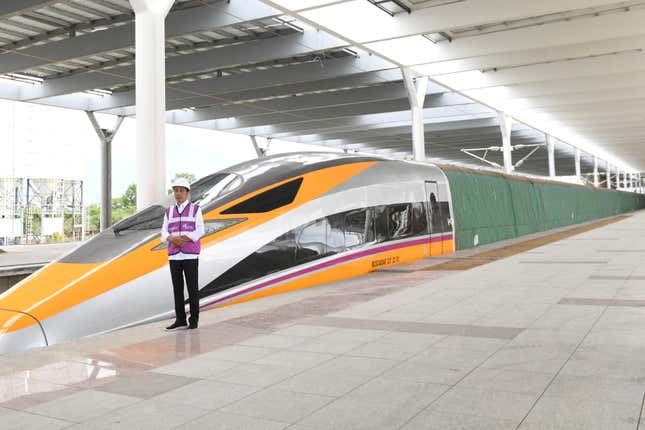
Indonesia’s first high-speed train, called Whoosh, launched commercial operations on Oct. 1. The service is the first of its kind in the country and in Southeast Asia, and a notch in the belt for Indonesian president Joko “Jokowi” Widodo. It’s also a milestone moment for Beijing’s Belt and Road Initiative (BRI), which helped bankroll the $7.3 billion project.
The new rail line traverses 88.4 miles (142.3 km), connecting Indonesia’s capital city of Jakarta to Bandung, the country’s second-most-populous metropolitan hub, located in the center of West Java. The bullet train will be able to reach speeds of about 217 mph (350 kph), cutting rail travel time between the two cities from about three hours to just 36 minutes.
“Whoosh” is aptly named: The onomatopoeia is also an acronym for “Waktu Hemat, Operasi Optimal, Sistem Handal,” which means “time-saving, optimal operation, reliable system” in Indonesian.
China and Japan vied for the Indonesian rail contract
Whoosh wouldn’t have been possible without funding from China, which beat out Japan—known for its seamless Shinkansen train service—in 2015 to lay claim to the contract. The bidding war between the two countries was as much a financial battle as a political one. China ultimately won out, a decision that Indonesia said was due to its preference for an approach that focused on business rather than government, as Forbes reported. Japan’s then–chief cabinet secretary, Suga Yoshihide, called the outcome “difficult to understand” and “extremely regrettable.”
For China, it was a coup. A joint venture between Jakarta and Beijing, Kereta Cepat Indonesia China (KCIC), now operates the new train. Whoosh also marks the first high-speed rail contract that China has secured and completed abroad, but it’s far from the last.
Where China’s railways extend, so too does its geopolitical influence
Since BRI’s inception in 2013, Chinese president Xi Jinping has envisioned railways as a means to extend the reach of not just his nation’s commerce, but also its currency and tourism.
Xi has framed his soft power strategy in “win-win” terms. “Infrastructure connectivity is the foundation of development through cooperation,” he said at the 2017 BRI forum. “We should build the Belt and Road into a road of opening up. Opening up brings progress while isolation results in backwardness.”
Whoosh is the latest addition to that vast, increasingly international network. While Indonesia’s high-speed rail is expected to have positive economic impacts for the country, the train is also a symbol of regional clout for China. Not all projects have been a success—the stalled Tinaco-Anaco railway in Venezuela is one example—but China has forged ahead with others.
A non-exhaustive list of places where China is building railways around the globe
🇨🇳↔️ 🇱🇦 In April, China Railway announced the launch of a China-Laos rail service that connects Kunming, the capital of China’s Yunnan province, and Vientiane, the capital of Laos. Another section connecting Bangkok to Kunming via Laos is due for completion in 2028.
🇭🇺↔️ 🇷🇸 China has also invested in a major European transport project connecting Belgrade and Budapest. The Hungarian government is financing 85% of the project, whose price tag is an estimated €3.8 billion ($4.02 billion), with a Chinese loan, as Investigate Europe reported. The project is scheduled to be completed in 2025.
🇪🇹↔️ 🇩🇯 Jumping to yet another continent, China helped build the 467-mile (752 km) Ethiopia-Djibouti rail line, a project that cost an estimated $4 billion. Commercial operations for the rail system, which is now integral in the Horn of Africa, began in 2018.
China’s investment in global transportation projects, by the digits
$51.9 billion: Fixed asset investments of China Railway, the state-owned passenger and freight rail corporation, from January to July 2023, marking a 7% year-over-year increase, according to China’s State Council Information Office
3,000 km (1,864 miles): Railway track China set out to build in 2023, as reported by Chinese state media outlet Global Times
$227.85 billion: Total BRI investment in transport projects from 2005–23, according to AEI’s China Global Investment Tracker
37,900 km (23,550 miles): Length of China’s domestic high-speed rail system—the most extensive globally, as reported by CNN
Related stories
🚆 Florida’s $5 billion new Brightline route is a big push for US investment in high-speed rail
🔀 The China-Europe rail freight boom sidesteps shipping chaos but not border disputes
🤔 As France launches an even better high-speed train, why is the US still so behind?



